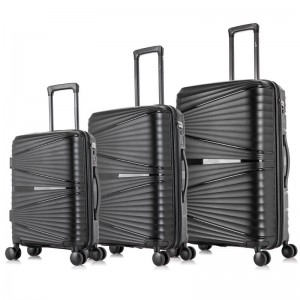1. Different materials
PP suitcases are polypropylene resins. Because homopolymer PP is very brittle when the temperature is higher than 0C, many commercial PP materials are random copolymers with 1~4% ethylene added or clamps with higher ethylene content. formula copolymer.
A PC in a PC suitcase is aka “polycarbonate”. Polycarbonate is a tough thermoplastic resin that gets its name from the CO3 groups inside it. By bisphenol A and carbon oxychloride synthesis. The most commonly used method is the melt transesterification method (bisphenol A and diphenyl carbonate are synthesized by transesterification and polycondensation).

2. Different characteristics
PP suitcase: The copolymer-type PP material has lower thermal distortion temperature (100C), low transparency, low gloss, low rigidity, but has stronger impact strength. The strength of PP increases with increasing ethylene content. The Vicat softening temperature of PP is 150C. Due to the high degree of crystallinity, this material has good surface stiffness and scratch resistance properties.
PC suitcase: It is an amorphous thermoplastic resin with excellent comprehensive properties, with excellent electrical insulation, elongation, dimensional stability and chemical resistance, high strength, heat resistance and cold resistance; also has Self-extinguishing, flame retardant, non-toxic, colorable, etc.
3. Different strength
PP suitcase: have stronger impact strength. The surface stiffness and scratch resistance properties of this material are excellent.
PC suitcase: Its strength can meet various needs from mobile phones to bulletproof glass. Compared with metal, its hardness is insufficient, which makes its appearance easier to scratch, but its strength and toughness are very good, whether it is heavy pressure or general , as long as you’re not trying to rock it, it’s long enough.






























